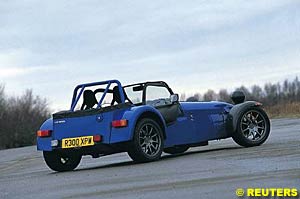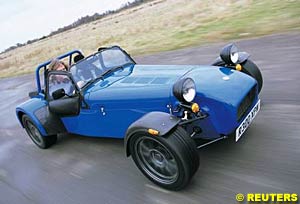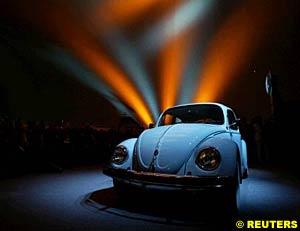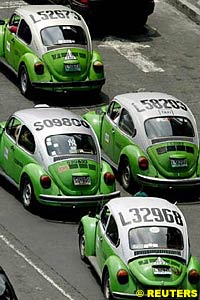

Automotive News and Reviews for the Petrolhead
Reuters Motoring Commentator
In this week's issue:
- Flying Low in the R300
- End of the Road for Iconic Beetle
'Add lightness' was Lotus founder Colin Chapman's mantra.
Yes, the enemy of speed is weight. Colin Chapman recognised this - arguably going too far in his quest for speed. Many racing drivers refused to drive his cars because too many chassis rails had been removed and some Lotus racers literally fell apart on the circuit.
Forty-six years on, it's a very different story. The Caterham-built 7 now shares no single component with the original Lotus. Instead of removing bits of the chassis, the Caterham does without traction control, anti-lock brakes, power steering, spare wheel, doors or roof.
R for Racer
The R in R300 stands for Racer. That's no idle claim, for there are more Caterhams racing in the world today than any other car. Caterham runs no less than six official national race series, providing some of the best racing anywhere in the world.
So what's the 300 bit? It refers to the car's power-to-weight ratio (300bhp per ton). This is where Caterham's nod to Colin Chapman becomes a full-scale headbang. By reducing weight as much as possible and adding a 160bhp engine from Rover into the mix, you get speed in spades. Overall weight is just 500kg, around a third of that of an average saloon car. It's this light partly because it's so small and partly because of all the lightweight bits that turn the 7 into a Superlight. We're talking about carbon fibre for the dash and front cycle wings and a stripped-out spec that does without a roof or sidescreens - even a windscreen (though my car had one fitted at extra cost and weight).
Luckily I'm roughly Colin Chapman's stature. Because he designed the car around his 5ft 6in frame, the 7's cockpit is the narrowest, most cramped place I've ever been in a car. (Caterham has recently launched a widened SV for fatties). But sandwiched in a bare composite racing seat, you do feel instantly at one with the car: a 7 is a tight-fitting racing suit.
Thundering Into Life
Press a button in the carbon-fibre dashboard and the engine thunders into life. Is that really an MG Rover X-Power engine under the bonnet? Yes, but no MG or Rover sounded anything like this, with a super-rorty exhaust spitting fire inches from your passenger's elbow.
As soon as you snick the tiny gearlever into first and pull off, you know this is going to be an exceptional drive. The engine barks up the rev band and almost instantaneously a series of lights flash on the dashboard to tell you to change up a gear. If you find a gearchange sharper than this, it would slice onions at forty paces.
Are there really only 160 horses under the bonnet? The acceleration is so intense that it feels like 260 - but that's what the magic of light weight does for you. I followed a pair of 362bhp Mercedes AMG E55s on a fast road and whatever they did, the little Caterham just stuck with them.
But the R300 is not really about straight line speed (although with a 0-60mph time of 4.7 seconds, it has it in abundance). It's about the astonishing way it despatches corners. The first corner you come to, you almost fly off the road because the steering wheel is so small, the hand movement required to change direction so slight and the directness so immediate that it takes you by surprise.
Unbelievable Grip
Are there any downsides to a weight of 500kg? The 7 does get jittery on bumpy roads, and is occasionally upset by uneven corners. Its ride quality is never anything more than bone-crunching. And refinement? Caterham obviously feels this adds weight too, because the R300 has none.
But if you think the R300 is as light and as fast as you can get, think again. The astonishing fact is that Caterham has not one but two even more extreme versions: the even more bonkers 200bhp R400 and the completely insane 230bhp R500 (weight just 465kg). These are among the very quickest-accelerating cars in the world today but they cost so much more than the R300 to deliver incrementally very little extra performance that the R300 is actually the best choice.
Written by Chris Rees
Conceived by Hitler but adopted by the hippie generation, the old-style Beetle has spluttered toward the sunset with the unveiling by Volkswagen of a final special edition of the much-loved car.
With more than 21 million units sold, Volkswagen boasts the Beetle is the most popular car ever made but it has succumbed in recent years to cheaper rivals from Nissan and Chevrolet. To commemorate the car's demise, Volkswagen is producing 3,000 special edition Beetles for sale only in Mexico.
"True stars know when it's time to retire and the public knows it too. This is what is happening to the Beetle," Jens Neumann, the head of Volkswagen's North American unit, said in a ceremony at the plant on Thursday.
The final version is a chrome-crowned and elegant younger brother of hardy little Herby, the simple Beetle with a mind of his own who starred in 1968 movie "The Love Bug".
The limited edition comes in either beige or powder blue and is adorned with whitewall tires, a CD player with four speakers plus chrome bumpers and other finishes. At 84,000 pesos, it costs about $1,300 (795 pounds) more than the typical old-style Beetle.
Volkswagen's Mexico plant will continue to make the New Beetle, a space-age "bug" that at between $20,000-25,000 is beyond the range of most traditional Beetle owners.
The old Beetle has inspired collectors and rallies around the world. The Indian city of Mumbai, home to only some 120 Beetles, has its own fan club.
"All of us treat our Beetles not like a car but like a member of the family who lives in the garage," said Enrique Wanzke, the head of a Beetle fan club in Mexico City where city taxis are green-and-white Beetles.
From Hitler to Hippies
Despite its later status as a counterculture icon of the 1960s, the Beetle was originally thought up in the mid-1930s by Nazi dictator Adolf Hitler.
He ordered designer Ferdinand Porsche to come up with an affordable "People's Car" (Volkswagen in German) that could seat two adults and three children. Production took off after the World War Two when the Beetle was a symbol of West Germany's economic miracle.
It has only made cars for the Mexican market in recent years but an influx of cheap foreign cars, like the Ford Fiesta and the Chevrolet "Pop" spelled the end for the Beetle.
"It's a bad feeling but on the other hand there is a last time for everything. The Volkswagen factory has to make a profit," said Beetle fan Hans Schuckenboehmer in Dortmund, Germany. He owns four Beetles and a military cousin of the Beetle, the World War Two amphibious "Schwimmwagen".
"People can remember their first love in a Beetle. The first kiss with their girlfriend. I can't tell you about my first love in a Beetle because my wife is standing here by the phone," Schuckenboehmer told Reuters by telephone.
Old-model Beetle sales from the Puebla plant almost halved from 2000 to 2002, when it produced just 24,500 cars. The factory has announced it plans to cut 2,000 jobs because of low demand abroad for its other models, mostly Jettas and New Beetles.
![]() Flying Low in the R300
Flying Low in the R300
 The Lotus 7 he created in 1957 is the very essence of this philosophy. Now Caterham - still making the 7 some 46 years later - has added a lot more than just lightness in the new R300.
The Lotus 7 he created in 1957 is the very essence of this philosophy. Now Caterham - still making the 7 some 46 years later - has added a lot more than just lightness in the new R300.
 It doesn't take long to get used to it, get into it and finally get gobsmacked by it. Ultra-quick steering provides feedback on every grain of gravel on the road. Specially-developed wide Avon CR500 tyres have unbelievable grip in the dry. If the R300 does lose grip - and it is only under severe provocation - it has the perfect chassis to reward a talented driver. Drifting out of line can be adjusted instantly and you soon have the glorious art of oversteer control at your fingertips.
It doesn't take long to get used to it, get into it and finally get gobsmacked by it. Ultra-quick steering provides feedback on every grain of gravel on the road. Specially-developed wide Avon CR500 tyres have unbelievable grip in the dry. If the R300 does lose grip - and it is only under severe provocation - it has the perfect chassis to reward a talented driver. Drifting out of line can be adjusted instantly and you soon have the glorious art of oversteer control at your fingertips.
![]() End of the Road for Iconic Beetle
End of the Road for Iconic Beetle
 The company will stop producing the classic old Beetles on July 30 at its plant in the central Mexican city of Puebla, the only factory in the world still making the "Bug".
The company will stop producing the classic old Beetles on July 30 at its plant in the central Mexican city of Puebla, the only factory in the world still making the "Bug".
 The car's distinctive air-cooled engine at the rear is what gives off that chugging noise that makes the Beetle sound more like an old dishwasher than an automobile. The Volkswagen plant in Mexico became the only factory in the world to make the old Beetle in 1996 when a factory in Brazil halted production.
The car's distinctive air-cooled engine at the rear is what gives off that chugging noise that makes the Beetle sound more like an old dishwasher than an automobile. The Volkswagen plant in Mexico became the only factory in the world to make the old Beetle in 1996 when a factory in Brazil halted production.
© 1995-2005 Kaizar.Com, Inc. . This service is provided under the Atlas F1 terms and conditions.
|
Volume 9, Issue 29
Atlas F1 Exclusive
Interview with Mike Gascoyne
Giancarlo Fisichella: Through the Visor
Articles
Season in the Sun
Rear View Mirror Returns
2003 British GP Preview
2003 British GP Preview
British GP Facts & Stats
Columns
The Fuel Stop
The F1 Trivia Quiz
Bookworm Critique
On the Road
Elsewhere in Racing
The Weekly Grapevine
> Homepage |